The coffee shop industry is booming, with a global trade worth $601.4 billion. In the US, the market is expected to hit $52.3 billion by 2025. This shows a lot of potential for cafes that are well-run. Also, 78.5% of restaurants and food places make it past their first year, proving the industry’s strength.
Coffee shops are known for their high profit margins, often over 90%. This means a single cup of coffee in the US can make a profit of $3.71. This has made coffee shops a popular choice for entrepreneurs and investors.
To succeed in the coffee shop business, you need a solid plan and a good understanding of the market. You must consider the initial costs, how to make money, and keep expenses low. This guide will cover everything you need to know to make the most of the coffee shop industry’s profit opportunities.
Key Takeaways
- The global coffee trade is worth a staggering $601.4 billion, with strong growth projected in the US market.
- Profit margins for coffee shops can reach up to 90% or higher, with a typical gross profit of $3.71 per cup.
- 78.5% of restaurants and food outlets successfully navigate their first year, showcasing the industry’s resilience.
- Understanding the initial investment requirements, revenue streams, and operating costs is crucial for achieving profitability.
- Optimizing menu pricing, inventory management, and marketing strategies can further enhance a coffee shop’s profitability.
Understanding the Coffee Shop Industry Landscape
The coffee shop industry is booming, thanks to a love for specialty drinks and premium coffee. In 2022, the coffee industry’s economic impact in the U.S. hit $343.2 billion, up 52.4% from 2015. People spent almost $110 billion on coffee that year, creating over 2.2 million jobs and earning over $100 billion in wages.
Current Market Size and Growth Trends
The U.S. coffee shop market is big and growing fast. By 2024, there were about 37,000 coffee shops, with a market size of $47 billion. Different coffee shop models make different amounts of money, from $528,000 to $1,160,000 a year.
Sit-in coffee shops make around $300 to $800 per year for every square foot. But kiosk-focused shops can make up to $1,300 per square foot.
Key Industry Statistics and Projections
The coffee industry is expected to keep growing. The global coffee market is worth over $400 billion a year. The U.S. coffee market alone is $85 billion annually, making up 20% of the global market.
Coffee shops are the third-largest restaurant category in the U.S., with 11% of sales among the top 200 chains. They’re growing faster than other big categories. The global coffee industry is expected to grow at mid-single-digit rates in the coming years, with international markets growing faster than the U.S.
Market Demographics and Consumer Behavior
Young people are getting more into coffee culture. In 2020, the average adult drank 42.6 liters of coffee a year. Coffee shops are seeing trends like iced coffee, nitro cold brew, and edible coffee products.
There’s also a rise in canned or bottled coffee and demand for non-dairy and plant-based coffee drinks.
| Metric | Value |
|---|---|
| Total economic impact of the coffee industry in the U.S. (2022) | $343.2 billion |
| Consumer spending on coffee (2022) | $110 billion |
| U.S. coffee industry jobs | 2.2 million |
| Number of coffee shops in the U.S. (2024) | 37,000 |
| Total U.S. coffee shop market size (2024) | $47 billion |
| Average revenue per coffee shop franchise (range) | $528,000 – $1,160,000 |
| Revenue per sq. ft. for sit-in coffee shops (range) | $300 – $800 |
| Revenue per sq. ft. for kiosk-focused coffee shops | Up to $1,300 |
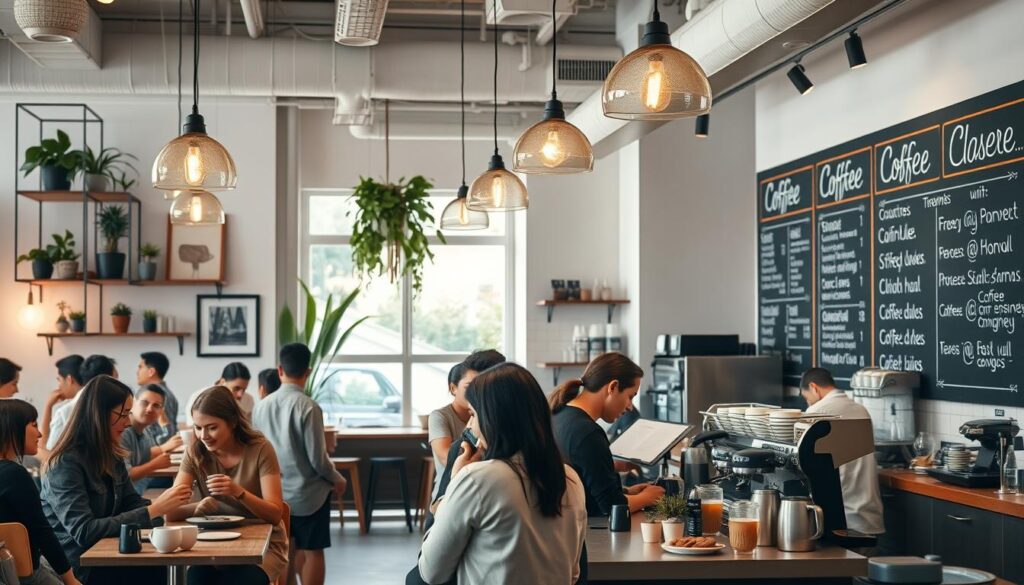
Are Coffee Shops Profitable? Breaking Down the Numbers
Thinking about starting a coffee shop? You might wonder if they make money. The truth is, the coffee business can be very profitable. Coffee shops can make a lot of money.
Quality arabica beans cost between $18 and $32 per kilo. This can make 120 to 140 cups of coffee. With coffee prices around $3.99, each cup makes about $3.71. But, how much money a coffee shop makes depends on many things like where it’s located and how well it runs.
| Key Coffee Shop Profit Statistics | Value |
|---|---|
| Percentage of Americans who drink coffee daily | 63% |
| Profit share of top 50 coffee shop chains | 70% |
| Gross margins for top coffee shop chains | Up to 85% |
| Average operating income for small coffee shops | 2.5% of gross sales |
| Minimum markup needed for coffee shop profitability | 25-30% |
To make money, coffee shops need to sell more than just coffee. They should also sell flavored syrups, hot teas, and more. Offering special drinks and treats can make things more exciting and help sell more.
The secret to success is to focus on quality and keep costs down. Running the shop well and keeping customers happy is key. With smart planning, a coffee shop can be very profitable.
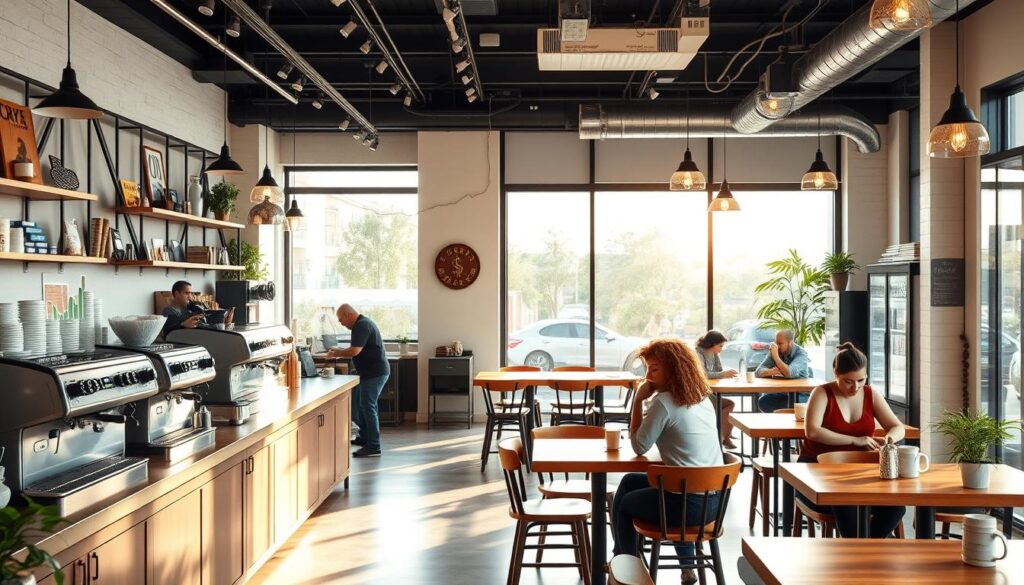
Initial Investment Requirements
Starting a coffee shop business needs a big initial investment. Costs can vary, from $35,000 for a coffee van to over $484,000 for a sit-down café. The amount depends on equipment, location, and legal needs.
Equipment and Setup Costs
Getting the right equipment is a big expense. High-quality espresso machines can cost up to $26,000. Industrial coffee roasters can cost between $8,000 and $50,000 or more. You’ll also need grinders, refrigeration, and barista tools. Costs for a traditional café can easily hit six figures.
Location and Lease Considerations
The location of your coffee shop is key. Rents, insurance, and other costs vary by area. A busy location can boost sales but also raises overhead. It’s important to study the competition and foot traffic to ensure profitability.
Licensing and Legal Requirements
Getting the right licenses and permits is crucial. You’ll need business licenses, food service permits, and liquor licenses if you serve alcohol. Not meeting these requirements can lead to fines and even closure.
Starting a coffee shop is a big financial step. But with careful planning, it can be rewarding and profitable. Understanding costs and legal needs helps prepare for success.
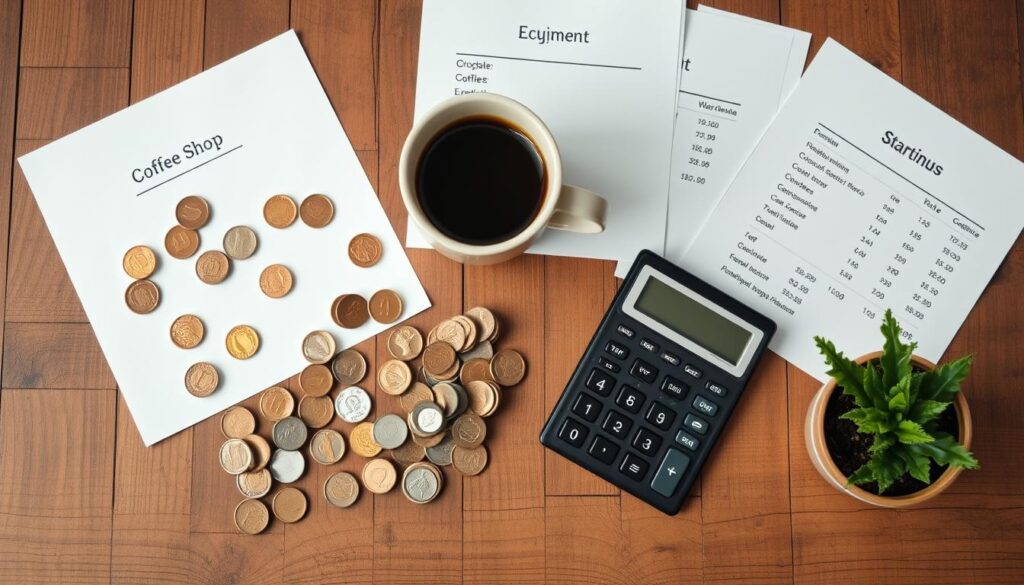
Average Profit Margins in Coffee Shop Business
The coffee shop industry is known for its high profit margins. Some top chains have gross margins up to 85%. But, the profitability can vary a lot. Small coffee shops usually make about 2.5% of their gross sales.
One reason for the high profit margins is the low cost of coffee beans and other materials. Generally, coffee shops need to run a 25-30% markup to make a profit. Also, selling items like flavored syrups, hot teas, and pastries can really help a coffee shop’s profits.
| Metric | Value |
|---|---|
| Average revenue per day in a coffee shop | $873 |
| Number of transactions per day | Around 79 |
| Average transaction amount | $11.11 |
| Typical profit margin for a coffee shop | Around 4% |
| Annual profit for a coffee shop | Monthly sales x Profit margin |
To make more money, coffee shop owners focus on their most profitable items. They also offer seasonal options and pairings to increase sales. Quality ingredients, presentation, and unique offerings can justify higher prices and increase profitability. Working with suppliers like Dilworth can also help in building menu profitability and success.
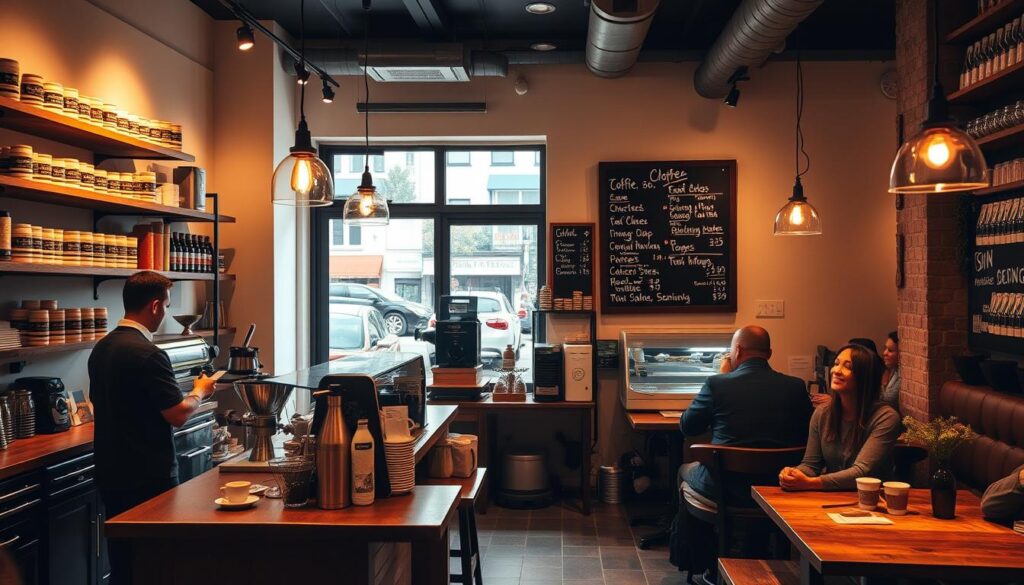
“The key to success in the coffee shop business is finding the right balance between high-profit items and customer satisfaction. It’s all about optimizing your menu and operations to maximize your bottom line.”
Revenue Streams and Income Potential
Being a coffee shop owner means knowing how to make money. Most of it comes from selling drinks, especially coffee. But, there are other ways to make money too.
Primary Revenue Sources
Coffee shops make most of their money from drinks. In the U.S., people drink over 651 million cups of coffee every day. By offering many types of coffee drinks, you can attract lots of customers.
Secondary Income Opportunities
- Food items: Adding food like baked goods and sandwiches can bring in more money and make customers happy.
- Merchandise sales: Selling items with your coffee shop’s logo, like mugs and t-shirts, can make extra money and help people remember your shop.
- Coffee bean sales: Selling high-quality coffee beans for people to use at home can make more money and keep customers coming back.
Seasonal Revenue Fluctuations
The money a coffee shop makes can change with the seasons. Sales might go up when it’s cold or with special menu items. By offering different things, you can keep your shop profitable all year.
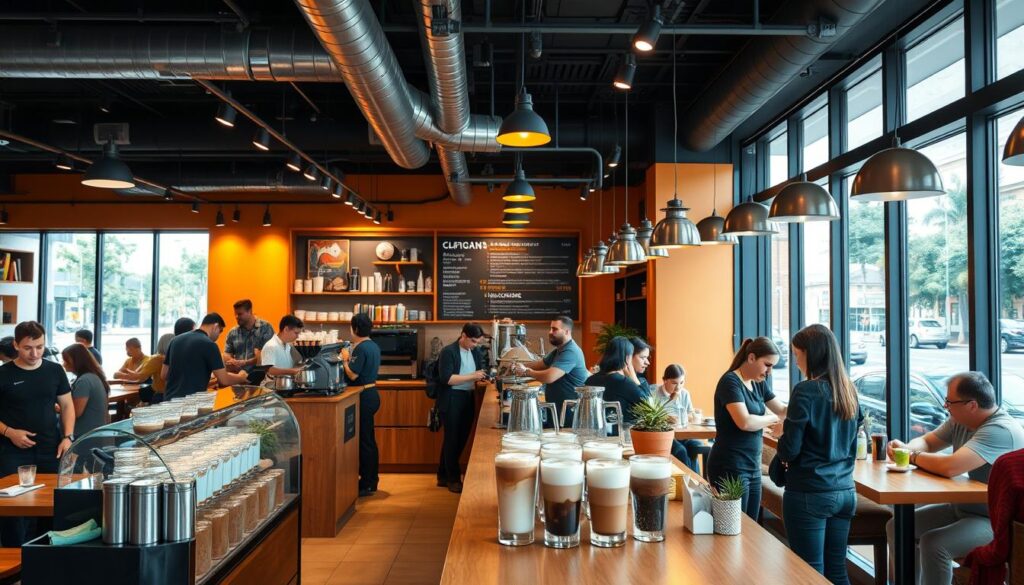
“Diversifying your income streams is key to maintaining a successful and resilient coffee shop business.”
Knowing how to make money from different sources and how sales can change helps you plan. This way, you can make your coffee shop profitable and successful for a long time.
Essential Operating Costs to Consider
Running a successful coffee shop means managing many costs. These include rent, utilities, labor, and inventory. Each expense is key to keeping the business profitable. It’s important for owners to understand and control these costs to make more money.
Rent and lease costs are often the biggest expenses, from $2,000 to $10,000 monthly. Utility bills, like electricity and water, add $500 to $1,500 monthly. Using energy-efficient methods helps keep these costs down.
Labor costs are a big variable, making up about 30% of total expenses. Pay for baristas, managers, and staff can be $4,000 to $20,000 monthly. Good scheduling and training are vital to keep labor costs low.
- Managing inventory, especially for items like dairy, is crucial. Coffee, tea, and supplies can cost $2,000 to $8,000 monthly, making up 25-30% of sales.
- Regular maintenance and repairs, like equipment upkeep, add $100 to $500 monthly to the budget.
- Other key costs include insurance ($250 to $1,500 monthly), marketing and advertising (5-10% of revenue), and miscellaneous supplies ($300 to $1,000 monthly).
By understanding and managing these coffee shop expenses, cafe operational costs, and coffee business overhead well, owners can ensure their business thrives in the long run.
Location Strategy for Maximum Profitability
Location is key for a coffee shop’s success. The right spot can bring in lots of customers and boost profits. But, the wrong place can lead to few visitors and low sales.
High-Traffic Areas vs. Neighborhood Spots
Choosing the right location is a tricky task. High-traffic spots near offices or universities can bring in more sales. But, neighborhood cafes can build a loyal community.
Think about your target market and brand when picking a location. If you want to attract commuters, choose a spot that’s easy to find. For a cozy local vibe, a residential area might be better.
Competition Analysis
It’s important to know who else is around. Being close to other cafes means you need to offer something special. This could be better prices, unique drinks, or top-notch service.
Find a location that’s easy to get to, visible, and fits your target audience. With careful planning, your coffee shop can thrive and succeed in the long run.
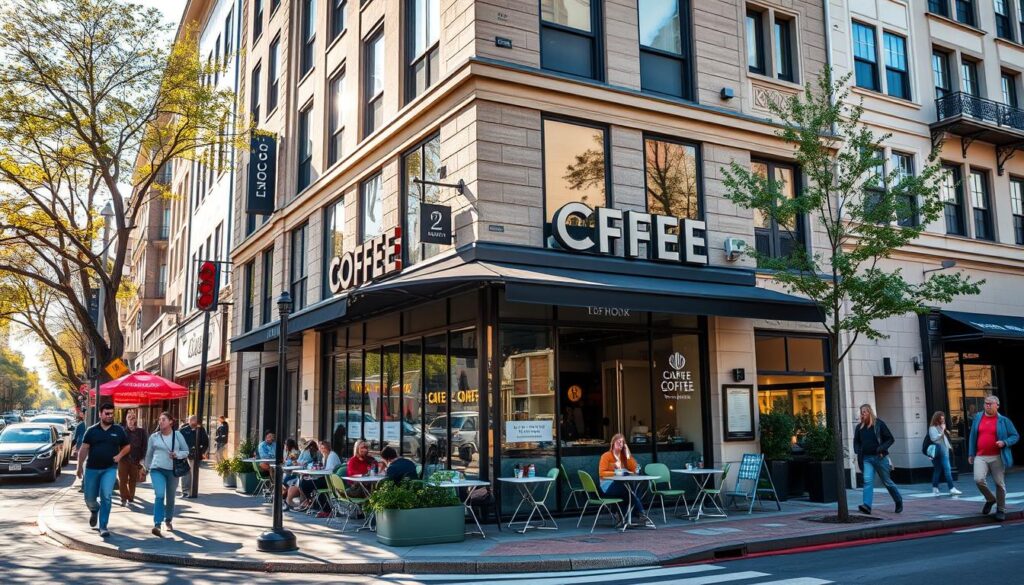
“The location of a coffee shop significantly impacts its success, with foot traffic being crucial in urban settings and car traffic more relevant in suburban or rural areas.”
Menu Pricing and Product Mix Optimization
Setting the right prices for your coffee shop is key to making money. You need to think about your costs, what others charge, and what your customers value. By choosing the right items, you can make more money and keep customers happy.
First, look at your cost of goods sold (COGS). This includes things like coffee beans and milk. Then, add a markup to set your prices. This cost-plus pricing strategy helps you make a good profit on each item.
| Item | COGS | Markup % | Selling Price |
|---|---|---|---|
| Latte | $1.50 | 80% | $4.00 |
| Drip Coffee | $0.75 | 80% | $2.00 |
| Pastry | $1.00 | 75% | $3.50 |
Don’t just use cost-plus pricing. Look at competitive pricing and value-based pricing too. This keeps your menu appealing and meets customer needs. Check your sales often to see what’s making you money and adjust your menu.
Try special drinks, seasonal items, and limited-time offers to increase profits. By always improving your menu, you’ll keep your customers coming back and make your coffee shop successful.
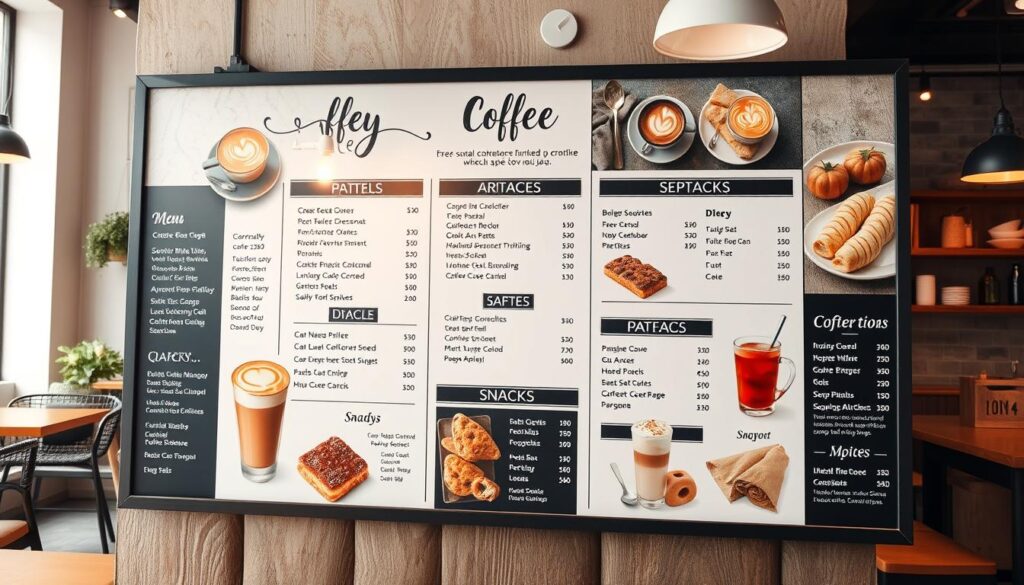
Staff Management and Labor Costs
Running a profitable coffee shop depends on good staff management. It’s key to have solid hiring and training strategies for quality service and to keep labor costs down. Also, using scheduling software to adjust staff levels during busy times can help a lot.
To keep your team lean and efficient, think about cross-training employees. This makes them more flexible and can lower labor costs. Don’t forget to focus on customer service training to make your customers happy and loyal. This can really boost your coffee shop’s profits.
Hiring and Training Strategies
- Develop a strong hiring process to find and keep good baristas and customer service staff
- Invest in detailed training to make sure employees can give great service
- Keep training going to keep your team updated with the latest trends and practices
Scheduling for Efficiency
- Use scheduling software that works with your sales data to adjust staff levels during busy times
- Have a flexible schedule that can change with the ups and downs of your business
- Train employees to do different jobs to make them more versatile and reduce the need for extra staff
| Key Labor Cost Benchmarks | Recommended Range |
|---|---|
| Labor Costs as a Percentage of Sales | 25-35% |
| Cost of Goods Sold (COGS) | 20-30% of sales |
By using smart coffee shop staffing and cafe employee management methods, you can cut down on coffee business labor costs. This can make your coffee shop more profitable.
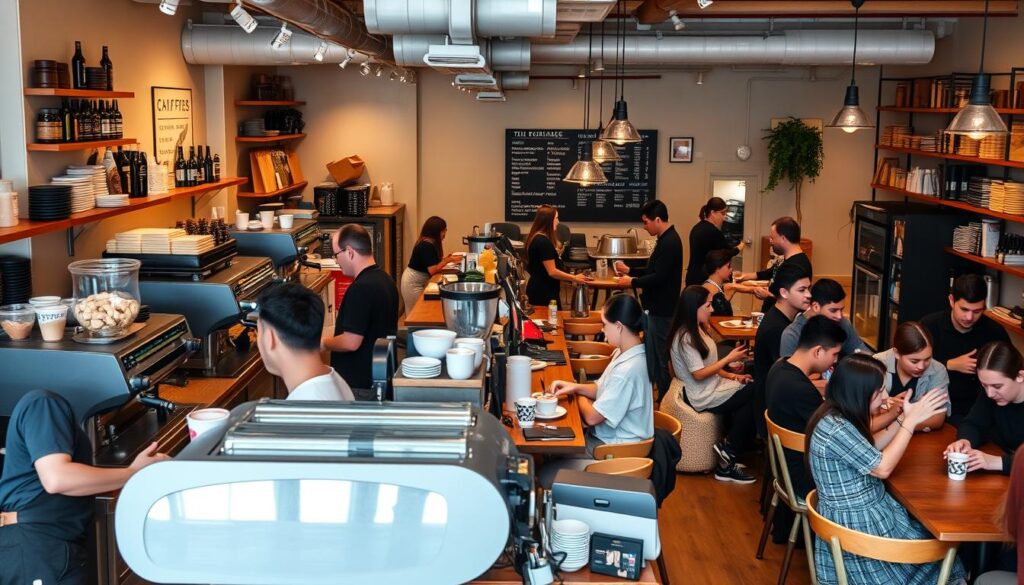
Marketing Strategies for Coffee Shop Success
Running a successful coffee shop is more than just serving great coffee. You need to market well to attract and keep customers. There are many ways to promote your coffee shop and stand out.
Start by using social media. Sites like Instagram, Facebook, and Twitter are great for showing off your drinks and talking to customers. Share photos of your drinks, give a peek into your shop, and chat with your followers.
Local marketing is also key. Work with nearby businesses, sponsor events, or host activities in your shop. This helps you connect with your community and build a strong brand.
Creating a strong brand is crucial. Make a memorable logo and pick colors that reflect your shop. Keep your look consistent in all your marketing. A clear brand helps customers know what your shop is about.
Finally, think about loyalty programs or special offers. Things like punch cards or free drinks can keep customers coming back. These programs can turn regulars into your biggest fans.
| Marketing Tactic | Potential Benefits |
|---|---|
| Social Media Engagement | Increased brand awareness, customer engagement, and customer acquisition |
| Local Community Partnerships | Enhanced brand reputation, networking opportunities, and customer loyalty |
| Cohesive Branding | Stronger brand identity, improved customer recognition, and differentiation from competitors |
| Loyalty Programs | Increased customer retention, repeat business, and word-of-mouth referrals |
With a good marketing plan that includes social media, local partnerships, branding, and loyalty programs, your coffee shop can thrive. This approach will help you succeed in the competitive coffee market.
“Effective marketing is the key to building a loyal customer base and driving long-term profitability for your coffee shop.”
Customer Loyalty Programs and Retention
In the competitive world of coffee shops, loyalty programs can greatly boost retention and increase average spend. A well-designed rewards system can encourage repeat visits and larger purchases from your most valuable customers. Using mobile apps can also make your loyalty program more effective, as 45% of consumers prefer services with mobile ordering and loyalty schemes.
Rewards System Implementation
When creating your coffee shop’s loyalty program, focus on a rewards system that appeals to your customers. Offering points or “beans” for every dollar spent is a popular choice. This lets customers get free drinks or perks after reaching a certain amount. It not only encourages repeat visits but also gives valuable data for your business decisions.
Community Building Initiatives
Consider more than just the transactional part of your loyalty program. Start community-building initiatives to create a sense of belonging. This could be through customer appreciation events, coffee workshops, or a loyalty-based social media group. Building a strong connection with your regulars can make your coffee shop stand out from big chains and improve retention.
| Key Loyalty Program Metrics | Benchmark Values |
|---|---|
| Referral Traffic | Indicates customer satisfaction and likelihood to recommend |
| Customer Retention Rate | Measures how many customers return to shop with you again |
| Customer Effort Score (CES) | Evaluate the effectiveness of your loyalty program |
| Net Promoter Score (NPS) | Crucial metric to gauge the success of your loyalty initiatives |
By setting up a well-designed coffee shop loyalty program, you can improve cafe customer retention and build a strong community among your loyal customers. Using data insights and community-building efforts can unlock your coffee business community engagement potential.

Inventory Management and Cost Control
As a coffee shop owner, keeping a close eye on your inventory is key to saving money. Using strong inventory management systems can really help your cafe’s profits. By tracking what you use every day, you can order better and cut down on waste.
Watch out for things that go bad fast, like milk, and order them in small amounts often. Making your recipes the same way helps track what you have and keeps your drinks and food good. Doing regular checks and finding ways to use less can also help your profits.
- Use the formula: starting inventory + received inventory – ending inventory = usage to figure out what you use.
- Divide your usage by sales to find out how much you spend on food and drinks. Aim for about 35% of what you sell it for.
- Keep your portion sizes the same to save money and keep your recipes consistent.
- Have a menu with items that can be used in different ways to cut down on waste and handle price changes.
Using top-quality ingredients is important for keeping your customers happy, but be careful not to spend too much. Keep an eye on your labor costs and make sure you’re serving the right amount of food and drinks.
Building good relationships with your suppliers can make managing your inventory and keeping your equipment in good shape easier. Using technology, like inventory software, can help you keep track of what you have, make reports, and make smart choices.
“Switching to spreadsheets for inventory was a big help when we opened a second location,” said Christy Wimberly from Honest Coffee.
Regularly check your inventory and adjust your prices and menu to keep up with the market. By getting good at coffee shop inventory, cafe cost control, and coffee business stock management, you can make your cafe more profitable and successful in the long run.
Technology Integration for Better Profits
In today’s digital world, adding technology can change the game for coffee shops. It helps streamline operations and boost profits. The right tech, like POS systems and online ordering, optimizes your business and meets customer needs.
POS Systems and Payment Solutions
A good POS system gives you deep insights into your business. It tracks sales, manages inventory, and analyzes data for better decisions. This frees staff to focus on customer service.
Mobile payments also improve the customer experience. They make transactions faster, leading to happier customers and more repeat business.
Online Ordering Platforms
Online ordering is now a must for many. Studies show 67% of users prefer it. An online ordering platform can expand your customer base and boost revenue.
These platforms offer features like real-time tracking and customizable menus. They make it easy for customers to order from you online.
Data analytics are key in optimizing your operations. Insights from POS systems and online platforms help refine your menu and strategies. This drives profitability for your coffee shop.
| Technology Integration Benefits | Key Statistics |
|---|---|
| Streamlined operations and data-driven insights | The global coffee shop market is projected to reach $450 billion by 2025 with a CAGR of 4.7% |
| Enhanced customer experience and convenience | 67% of users prefer to order food and beverages online |
| Increased revenue and profitability | Combining premium coffee with healthy snacks can achieve a combined profitability that exceeds 30% |
By using coffee shop technology, cafe POS systems, and coffee business online ordering solutions, you can grow and profit more in your coffee shop.
Scaling and Expansion Opportunities
When your coffee shop is doing well, it’s time to think about growing. You could open more shops, start a franchise, or even sell coffee beans wholesale. These steps can help your business grow a lot.
First, look at what people want and what’s happening in the market. Make sure you have a solid plan for how to keep everything running smoothly as you grow. This is key to keeping quality high and profits up.
- Use data and trends to find the best places to open new shops.
- Think about franchising to grow your business faster.
- Look into other ways to make money, like roasting coffee or selling beans to other shops.
Intuit says 17 million new small businesses will start in 2022. This shows the coffee shop world is growing fast. By carefully planning how to grow, you can make your coffee shop a big success.
“A good plan is to open one store each year. By the fourth store, you’ll likely be profitable. With the right partner, you can grow from four to dozens of stores.”
Invest in your team to help you grow. Happy customers are also key, spreading the word about your shop. Use social media and a strong brand to keep your business growing.
Common Challenges and Solutions
Running a successful coffee shop is not easy. It faces many challenges, like being competitive and keeping quality high. Let’s look at some common problems and how to solve them to make your coffee shop thrive.
Quality Control Challenges
Keeping your coffee quality high is key to happy customers. But, issues like bad storage, not knowing enough, and pricing can hurt quality. To fix this, train your staff well, check quality closely, and store your coffee beans right.
Supply Chain Disruptions
The coffee supply chain can face problems like labor shortages and shipping delays. To stay ahead, build strong supplier relationships, find different sources, and plan for delays. This keeps your coffee fresh and of high quality.
Intense Competition
The coffee shop market is very competitive. To stand out, know your customers and create a unique brand. Use good marketing to get noticed and keep customers coming back.
Equipment Maintenance and Upkeep
Keeping your equipment in good shape is vital. Regular cleaning and checks on machines are key to quality and avoiding problems. Make sure to set aside time and money for maintenance and fix issues quickly.
Premises Upkeep
A clean and welcoming cafe is important for a good customer experience. Spend time and money on cleaning, repairs, and upkeep. This makes your coffee shop a place people want to visit.
High Initial Investment
Starting a coffee shop costs a lot. You need money for the space, staff, and perfecting your offerings. Plan your budget well, look for funding, and be ready for the first few years to build a strong base.
Staffing and Labor Costs
Labor costs are a big part of your expenses. Managing your staff well is key. Hire and train smart, schedule wisely, and use technology to manage your team and costs.
By tackling these challenges with smart solutions, coffee shop owners can succeed. Stay flexible, listen to customers and staff, and be open to change. This will help your coffee shop grow and stay profitable in the long run.
Conclusion
Coffee shops can be very profitable if run well. Success depends on several things like a good location and high-quality products. Also, being efficient and giving great customer service matters a lot.
The coffee industry is looking up, with more people wanting specialty coffee and unique cafe experiences. By focusing on what makes your coffee shop stand out, you can make it thrive. This includes managing costs, using smart marketing, and keeping up with new trends.
Your coffee shop’s success depends on understanding the market and what makes it special. It’s about delivering value to your customers. Stay in touch with industry changes, run your shop well, and always look for ways to improve. This way, your cafe can succeed in the fast-changing world of specialty coffee.
